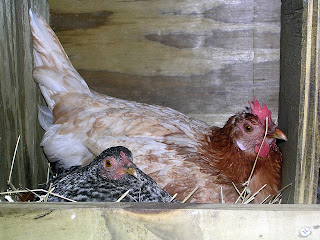 |
An egg laid by one of my hens.
Notice the thick shell and beautiful yolk. |
In my post
Eggs: A Perfect Food, I talked about some of the health benefits of eggs. However, I left out an important aspect:
not all eggs are of equal nutritional quality. In this post, I’m going to talk about some of the differences between eggs from healthy free-range hens and eggs from battery-caged hens (mass-produced).
Pasture-fed, cage-free eggs are nutritionally superior to eggs sold at the grocery store, which are from overworked caged hens. Hens used for commercial production are kept in small cages… or “chicken concentration camps.” Instead of being outdoors, they are caged inside a noisy crowded chicken house. The hens are kept so close together that they need to have their beaks trimmed in order to prevent feather picking and cannibalism. I have read many horrific details about the way eggs are produced in mass scale… but since I can’t speak for the conditions of every large-scale egg producer, I’m going to focus on how eggs should be raised.
My free-range hens are able to eat grass, scratch in the dirt, eat bugs, and live how chickens are designed to live. Nutrients from grass and insects are what make their eggs so great. My chickens get sunshine, constant fresh air, and room to flap their wings and run. My chickens are also supplemented with high-quality, non-medicated, low soy feed that does not contain preservatives. This ensures they get all the nutritious food needed to produce eggs regularly. This is how laying hens should be raised. Consequently, my chickens are very healthy. They produce excellent eggs which help to keep me and my family healthy.
 |
| I don't know why they insisted on using the same nesting box...Haha |
My family and I have so much trust in our healthy hens and eggs that we sometimes eat our eggs in raw forms (such as in homemade mayonnaise). Salmonella is only to be worried about when eating eggs that come from dirty crowded hens. Commercial hens are overly fed antibiotics, which causes pathogens to build up resistances and grow stronger. There is nothing to worry about from eggs from my own chickens. My chickens have many acres of woods and grass that they can roam around in all day to keep them healthy. They are disease-free with shinny feathers and brightly colored combs and waddles.
 |
| Eggs of different size and color |
The appearance/color of an egg yolk and the thickness of the shell is one way to tell the nutritional quality of an egg. Free-range shells are not thin. They don’t crack easily. You should need to gently hit it on the counter a couple times for it to break.
More importantly, the color of the yolk represents the nutritional quality of the egg.
Eggs from healthy chickens should have yolks which are a rich bright orange color (not yellow). The yolks from healthy chickens are firm, round, and do not break easily (ideal for when you need to separate eggs for a recipe).
I call the eggs I gather from my free-range hens “gold” because their value is truly of the same worth. This is because of the work and time that goes into producing healthy eggs from healthy chickens.
 |
| Free-range chickens |
In conclusion, eating eggs from the store is better than not eating eggs at all. Organic or free-range eggs from the store are better than regular store eggs to an extent. The term “free-range” as used on eggs from the store does not necessarily mean the eggs are truly free-range. The label “free-range” can mean anything from a very tiny door which the hens will not use, to an outside pen that has no grass. Fresh eggs, from a small farmer who provides his/her hens with a yard to forage in, are by far the best you can buy.
That being said, there is a good reason for price differences between store eggs and true free-range eggs. Small farmers can’t compete with large government subsidized corporations. Even organic grocery store eggs, which do not come close to small farm free-range eggs, have to be a higher price due to strict organic feed standards.
High-quality eggs from happy healthy chickens can never be produced on a large-scale. If we wish to stay healthy and for the next generation to be healthy, the solution is to replace cheap, mass-produced, eggs with many small farms of only a small flock of chickens. If you have a yard, the best way to get quality eggs is to raise them yourself! Just a few chickens can provide a family with all the eggs they need, and enough to share.
Support local small farming!
Thanks for reading.



















